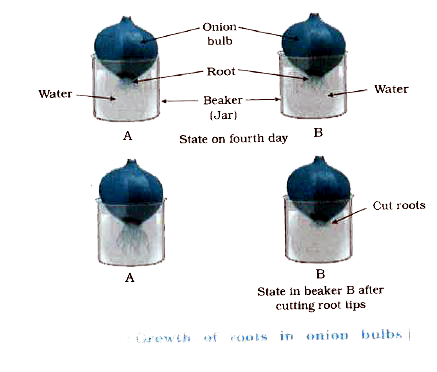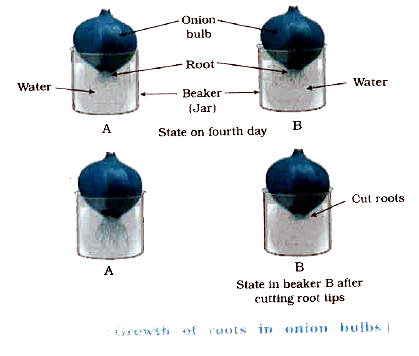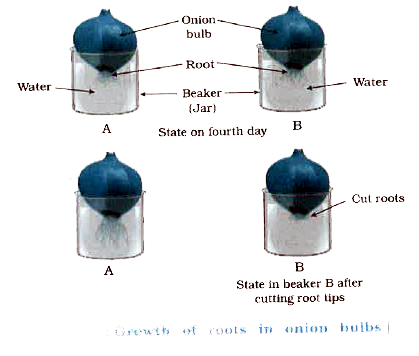Complete Solutions to ACTIVITY of chapter TISSUES of Class 9 book with complete answers and questions
| Class 9 | BIOLOGY |
| Chapter | TISSUES |
| KUMAR PRAKASHAN | ACTIVITY |
| Number Of Questions | 8 |
| Academic Year | 2023-24 |
Take two glass jars and fill them with water.
Now, take tow onion bulbs and place one on each jar, as shown in fig 6.1

Observe the growth of roots in both the bubls for a few days.
Measure the lenght of roots on day 1,2 and 3.
On day 4, cut the root tips of the onion bulb in jar 2 by about 1 cm. After this, ovbserve the growth of roots in both the jars and measure their lengths each day for live more days and record the observations. Which of the two onions has longer roots ?
View SolutionTake two glass jars and fill them with water.
Now, take tow onion bulbs and place one on each jar, as shown in fig 6.1

Observe the growth of roots in both the bubls for a few days.
Measure the lenght of roots on day 1,2 and 3.
On day 4, cut the root tips of the onion bulb in jar 2 by about 1 cm. After this, ovbserve the growth of roots in both the jars and measure their lengths each day for live more days and record the observations. Do the roots continue growing even after wehave removed their tips?
View SolutionTake two glass jars and fill them with water.
Now, take tow onion bulbs and place one on each jar, as shown in fig 6.1

Observe the growth of roots in both the bubls for a few days.
Measure the lenght of roots on day 1,2 and 3.
On day 4, cut the root tips of the onion bulb in jar 2 by about 1 cm. After this, ovbserve the growth of roots in both the jars and measure their lengths each day for live more days and record the observations. Why would the tips stop growing in jar 2 after we cut them?
View SolutionTake a plant stem and with the help of your teacher cut into very thin silces or sections.
Now, stain the slices with safranin. Place one neatly cut section on a slide and put a drop of glycerine.
Cover with a slip and observe under a microscope. Observe the various types of cells and their arrangement. Are all cells similar in structure ?
View SolutionTake a plant stem and with the help of your teacher cut into very thin silces or sections.
Now, stain the slices with safranin. Place one neatly cut section on a slide and put a drop of glycerine.
Cover with a slip and observe under a microscope. Observe the various types of cells and their arrangement. How many types of cells can be seen ?
View SolutionTake a plant stem and with the help of your teacher cut into very thin silces or sections.
Now, stain the slices with safranin. Place one neatly cut section on a slide and put a drop of glycerine.
Cover with a slip and observe under a microscope. Observe the various types of cells and their arrangement. Can we think of reasons why there would be so many types of cells ?
View SolutionTake a freshyl plucked leaf of Rhoeo.
Strech and break it by applying pressure.
While breaking it. Keep it stretched gently so that some peel or skin projects out from the cut.
Remove this peel put it in a petri dish filled with water.
Add a few drops of safranim.
Wait for a couple of minutes and then transfer in onto a slide. Gently place a cover slip over it.
Observe under microscope.
Observation :
A peel of Rhoeo leaf if mounted on the slide and observed under a microscope, it reveals the structure of a leaf. The cells of epidermis and stomata are seen when observed.
Structure of a leaf :
Outermost layer of the leaf is made - up of single layered cells called epidermis.
Epidermis layer does not have intercellular spaces. The cells are flat, with outer and side walls thicker than the inner wall.
Small pores, i.e., stomata are seen in the epidermal layer.
Stomata help in transpiration and gaseous exchange.
Desert plants have thicker epidermis for protection. In dry habitats, water loss is the critical problem. The entire surface of the plant is therefore covered over by epidermis.
Aerial parts of the plant are covered by epidermal cells. They secrete water - resistant, waxy layer for the purpose of protection.
Epidermal cells also protect the plant from mechanical injury and parasitic invasion of fungi. Think about which gas may be required for photosynthesis.
View SolutionTake a freshyl plucked leaf of Rhoeo.
Strech and break it by applying pressure.
While breaking it. Keep it stretched gently so that some peel or skin projects out from the cut.
Remove this peel put it in a petri dish filled with water.
Add a few drops of safranim.
Wait for a couple of minutes and then transfer in onto a slide. Gently place a cover slip over it.
Observe under microscope.
Observation :
A peel of Rhoeo leaf if mounted on the slide and observed under a microscope, it reveals the structure of a leaf. The cells of epidermis and stomata are seen when observed.
Structure of a leaf :
Outermost layer of the leaf is made - up of single layered cells called epidermis.
Epidermis layer does not have intercellular spaces. The cells are flat, with outer and side walls thicker than the inner wall.
Small pores, i.e., stomata are seen in the epidermal layer.
Stomata help in transpiration and gaseous exchange.
Desert plants have thicker epidermis for protection. In dry habitats, water loss is the critical problem. The entire surface of the plant is therefore covered over by epidermis.
Aerial parts of the plant are covered by epidermal cells. They secrete water - resistant, waxy layer for the purpose of protection.
Epidermal cells also protect the plant from mechanical injury and parasitic invasion of fungi. Find out the role of transpiration in plants.
View Solution
ACTIVITY questions and complete solutions for chapter TISSUES of KUMAR PRAKASHAN KENDRA BIOLOGY (GUJRATI ENGLISH) of Class 9
All Exercises from KUMAR PRAKASHAN Class 9 BIOLOGY TISSUES
- ACTIVITY
- NEXT QUESTIONS AND ANSWERS
- QUESTION AND ANSWER (ANSWER THE FOLLOWING QUESTION IN BRIEF : (3 MARKS EACH)
- QUESTION AND ANSWERS (ANSWER THE FOLLOWING QUESTION IN DETAIL : (4 MARKS EACH)
- QUESTION AND ANSWERS (ANSWER THE FOLLOWING QUESTION IN SHORT : (2 MARKS RECH)
- QUESTION AND ANSWERS (CHOOSE THE CORRECT OPTION FROM THOSE GIVEN BELOW EACH QUESTION : (1 MARK EACH)
- QUESTION AND ANSWERS (DISTINGUISH BETWEEN THE FOLLOWING : (2 OR 3 MARK EACH)
- QUESTION AND ANSWERS (FILL IN THE BLANKS : (1 MARK EACH)
- QUESTION AND ANSWERS (FILL IN THE BLANKS BY SELECTING THE CORRECT ALTERNATIVE FROM THOSE GIVEN IN THE BRACKET : (1 MARK EACH)
- QUESTION AND ANSWERS (GIVE SCIENTIFIC REASONS FOR THE FOLLOWING STATEMENTS : (2 MARKS EACH)
- QUESTION AND ANSWERS (MATCH THE FOLLOWING PROPERTY : (2 MARKS EACH)
- QUESTION AND ANSWERS (STATE WHETHER THE FOLLOWING STATEMENTS ARE TURE OF FALSE : (1 MARK EACH)
- QUESTION BASED ON PRACTICAL SKILLS WITH ANSWERS (SELECT THE APPROPRIATE OPTION AND COMPLETE THE SENTENCE :
- QUESTIONS AND ANSWER (ANSWER THE FOLLOWNG QUESTION IN ONE WORD OR ONE SENTENCE : (1 MARK EACH)
- QUESTIONS AND ANSWER (IDENTIFY THE TYPE OF TISSUE IN THE FOLLOWING : (1 MARK EACH)
- QUESTIONS AND ANSWERS ( DRAW THE LABELLED DIAGRAM) :
- QUESTIONS AND ANSWERS (ANSWER THE FOLLOWING QUESTIONS IN VERY SHORT : (1 MARK EACH)
- QUESTIONS AND ANSWERS (NAME THE FOLLOWING :(1 MARK EACH)
- VALUE BASED QUESTIONS WITH ANSWERS